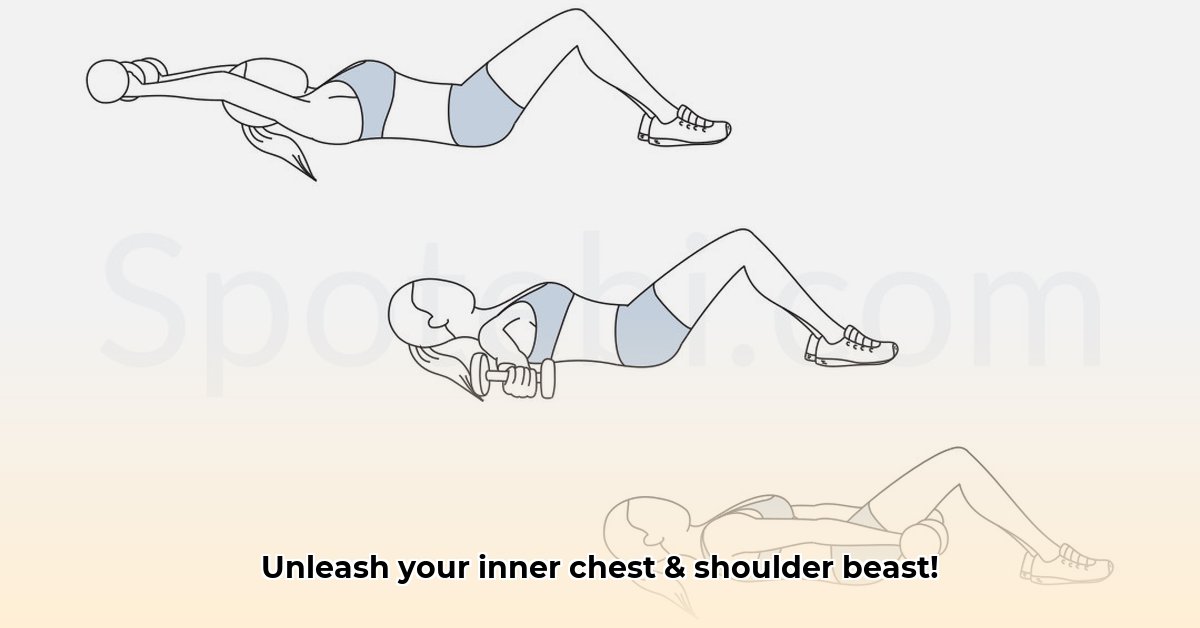Want to sculpt your upper body, enhance shoulder mobility, and boost chest and shoulder strength? The “Around-the-World” exercise might be the key. It targets your chest and shoulders in a unique way, potentially building muscle and improving flexibility. This guide provides a comprehensive explanation of how to perform the exercise safely and effectively, including proper form, variations, common errors, and programming suggestions. Get ready to level up your upper body training regimen!
Demystifying the Around the World Exercise for Strength Training
Ready to sculpt your upper body and boost shoulder mobility? The “around the world” exercise might be your new best friend. It is a dynamic movement that works your chest and shoulders, offering a rewarding workout.
How to Perform the Around the World Exercise Properly
This exercise relies on controlled, circular movements. Let’s break it down step-by-step:
- Get Set: Start by lying on a flat bench with your feet firmly planted on the ground. Hold a light dumbbell in each hand, palms facing each other. Extend your arms straight up over your chest, maintaining a slight bend in your elbows.
- The Descent: Slowly lower your arms out to the sides in a wide arc, keeping the slight bend in your elbows. Your palms should be facing upwards as you reach the bottom of the movement. Focus on feeling a stretch in your chest and shoulder muscles.
- The Sweep: Initiate the “around the world” motion by sweeping your arms in a smooth, controlled arc towards the top of your head. Keep your arms slightly bent throughout this phase.
- The Return: Continue the circular motion, bringing your arms back down towards your hips, completing one full rotation. Maintain consistent, controlled tension throughout the exercise.
- Repeat and Reverse: Perform several repetitions in one direction, then reverse the motion and repeat, sweeping your arms from your hips back towards the top of your head.
- Seated Variation: This can also be done sitting or standing. When standing, maintain core engagement and a slight bend in your knees for stability. When seated, use a bench with or without back support.
- Breathing: Inhale deeply as you lower your arms and exhale as you bring your arms back to the starting position.
Muscles Worked Actively During the Around The World Exercise
This exercise involves a comprehensive upper body engagement! Primarily, you’ll feel it in your:
- Pectoralis Major (Chest): The primary target of this exercise, especially the lower and middle fibers. The circular motion provides a unique stretch and contraction.
- Deltoids (Shoulders): All three heads (anterior, medial, and posterior) are engaged, with the anterior deltoid playing a significant role in the forward movement of the arms.
- Latissimus Dorsi (Back): These muscles assist in controlling the downward motion of the arms, providing stability and preventing shoulder impingement.
- Rotator Cuff: The rotator cuff muscles (supraspinatus, infraspinatus, teres minor, and subscapularis) work to stabilize the shoulder joint throughout the exercise.
- Triceps (Back of Upper Arm): Assist in extending and stabilizing your arms.
- Core: Engaged for stability, especially during the standing variation.
The specific muscles emphasized vary slightly depending on the variation and individual biomechanics.
Benefits of Around the World Exercise for Upper Body Strength
The around-the-world exercise offers several key benefits, including:
- Improved Shoulder Mobility: The circular motion encourages a greater range of motion in the shoulder joints, which can improve flexibility and reduce stiffness.
- Enhanced Muscle Activation: Activates a greater number of muscle fibers in your shoulders and chest compared to traditional pressing exercises, leading to more balanced muscle development.
- Muscle Growth Potential: Consistent performance with progressive overload stimulates muscle growth (hypertrophy) in your chest and shoulders.
- Warm-up and Cool-Down Versatility: Perfect as a warm-up to prepare for heavier lifting, promoting blood flow and joint lubrication, or as a cool-down to improve flexibility and reduce post-workout muscle soreness.
- Improved Posture: Strengthening the muscles of the chest and shoulders can help improve posture and reduce rounded shoulders.
- Core Stabilization: The standing version also engages the core, further enhancing stability.
- Increased Mind-Muscle Connection: Requires focus and control, improving your awareness of the muscles being worked.
Risks and Precautions to Note
While generally safe, the around-the-world exercise does carry some potential risks, especially if performed incorrectly:
- Shoulder Impingement: Incorrect form, excessive weight, or pre-existing shoulder conditions can increase the risk of shoulder impingement, where tendons in the shoulder are compressed.
- Shoulder Strain: The most significant risk is strain or injury to the shoulder joint, typically caused by using excessive weight, performing jerky motions, or pre-existing conditions. Always prioritize proper form.
- Muscle Strain: Overexertion can lead to muscle strains or tears, particularly in the chest, shoulders, or back. Avoid this by starting with a manageable weight.
- Pre-existing Conditions: If you have any pre-existing shoulder or upper body injuries, rotator cuff issues, or other musculoskeletal problems, consult with your doctor or physical therapist before incorporating this exercise into your routine.
- Neck Strain: Avoid tensing the neck. Keep it relaxed and in a neutral position.
Around the World Activation Exercise: Programming Suggestions
Here are some sample workout programs to incorporate the around-the-world exercise into your routine:
| Program Type | Sets | Reps | Weight Recommendation | Rest Between Sets | Focus | Example Incorporation |
|---|---|---|---|---|---|---|
| Warm-up | 2 | 10-15 | Very Light | Short (30-60 sec) | Mobility and activation | Before chest or shoulder workout, focus on controlled movements, feeling the muscles engage. |
| Finisher | 3 | 15-20 | Light to Moderate | Short (30-60 sec) | Endurance and muscle burn | At the end of your chest or shoulder workout to fully exhaust the muscles. |
| Main Routine | 3 | 8-12 | Challenging (but safe) | Longer (1-2 min) | Strength and hypertrophy | As part of a chest or shoulder routine, focusing on controlled movements and feeling the muscles work. Pair with other chest and shoulder exercises. |
| Shoulder Rehab | 2-3 | 10-12 | Extremely Light | 60-90 sec | Controlled ROM, Pain Reduction | Under guidance of a physical therapist, focusing on pain-free movements to improve shoulder function. |
Adjust the weight and reps based on your fitness level and goals. Remember to listen to your body and adjust as needed. If you are new to this exercise, start with lighter weights and focus on mastering the correct form before increasing the weight.
Common Mistakes and Corrections in Around the World Exercise
Avoid these common mistakes to maximize results and minimize injury risks:
- Jerky Movements: Avoid jerky or sudden movements. Maintain slow, controlled circular motions. Focus on smooth, fluid movements throughout the entire exercise.
- Excessive Weight: Don’t start with too heavy a weight. Begin with a weight that allows you to complete the repetitions with good form. This exercise is about control and range of motion, not lifting heavy.
- Incomplete Range of Motion: Ensure you use your full range of motion. Don’t cut the movement short. Reach as far as comfortably possible in each direction.
- Locked Elbows: Keep a slight bend in your elbows throughout the exercise to protect the elbow joints.
- Arching Back: Avoid excessive arching of your back, especially during the lying variation. Maintain a neutral spine and engage your core for stability.
- Holding Breath: Breathe consistently throughout the exercise. Exhale during the most challenging portion of the movement (as you bring your arms back to the starting position) and inhale as you lower the weight.
Variations and Progressions/Regressions for Better Execution
To keep your workouts engaging, you can easily progress or regress the around-the-world exercise to suit your fitness level:
Regressions (Easier):
- Reduce Weight: Use lighter dumbbells or even just bodyweight.
- Decrease Reps: Perform fewer repetitions per set.
- Reduce Range of Motion: Perform smaller circle movements if a full rotation is too difficult. Gradually increase the range of motion as your flexibility improves.
- Seated Variation: Performing the exercise seated provides more stability and can be easier for beginners.
- Resistance Bands: Use resistance bands to add a constant level of tension throughout the entire motion.
Progressions (Harder):
- Increase Weight: Gradually increase the dumbbell weight as you build strength.
- Increase Reps: Add more repetitions to each set.
- Add a Pause: Pause briefly at the bottom or top of the movement to increase time under tension and challenge your stability.
- Standing on an Unstable Surface: Perform the standing variation on a BOSU ball or balance board to further engage
- Wind Power Energy Advantages: Clean, Domestic And Cost-Effective Power - November 12, 2025
- Wind Turbine Pieces: Examining The Industrys Future Growth - November 9, 2025
- Wind Turbine Installation: Building the Future of Energy - November 7, 2025
















